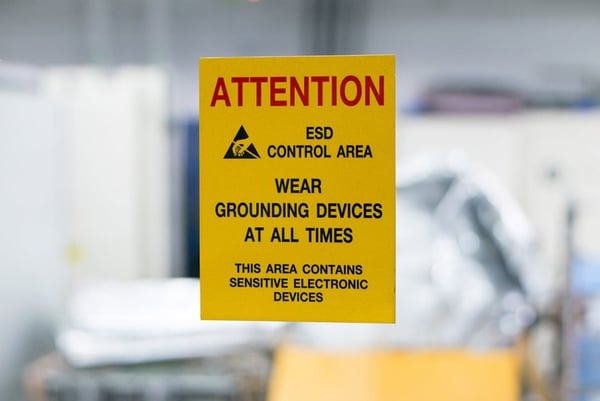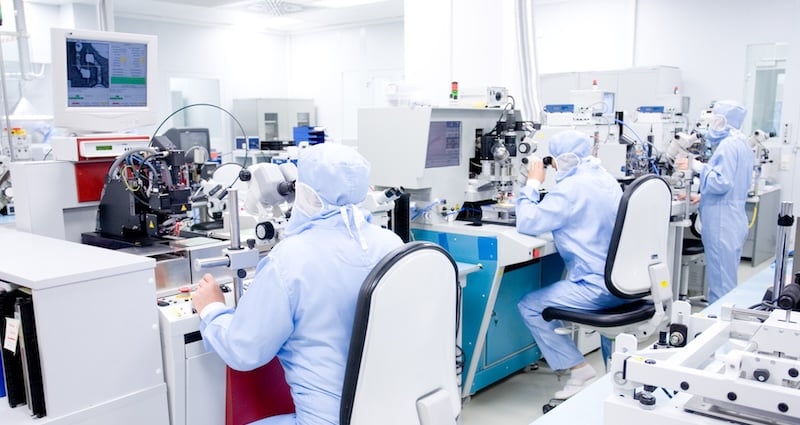Electrostatic discharge (ESD) is a major concern in many manufacturing and industrial applications. Static can easily damage delicate electronics or medical device components – in some cases without warning or sign until after manufacturing is nearly completed. As a result, one of the most critical components for controlled environment manufacturing is a swab that is specially constructed to clean small surfaces, and consistently apply precise amounts of solvents, all without the risk of transmitting damaging static shocks.
To select the most appropriate tool for these delicate jobs, it’s important to know your risks and understand what materials provide the best properties for ESD safe swabs.
What is ESD?
Electrostatic discharge (ESD) is the rapid emission of static electricity that occurs when a positively charged object touches a material with a negative charge. In layman’s terms, this buildup occurs when materials with differing charges slide or rub against one another. We feel ESD in many common occurrences, such as pulling static-filled laundry out of the drier or the slight shock of walking across a carpet and then touching a metal doorknob.
In the examples noted here, ESD can create a mild, if unpleasant, shock. However, in delicate manufacturing and other industrial processes, the heat generated by this shock can be incredibly destructive. In fact, it can vaporize minute electronic components. Static buildup can also attract contaminants to sensitive surfaces and cause delicate materials to adhere to one another.
What is an ESD safe swab?
An ESD safe swab is manufactured specifically to prevent this static buildup. These applicators are made with anti-static handles and unique tips to prevent the electron transfer that can damage static-sensitive materials.
What are the ideal ESD safe swab materials?
ESD materials come in several categories:
- Anti-static materials prevent the build-up of static electricity due to their high surface resistivity. While standard foam might normally allow static to build-up, ESD foams are chemically treated with agents that prevent their ability to generate a static charge.
- Conductive materials allow the easy flow of electrons, meaning that any potential electric charge is quickly dispersed. Many natural materials, including cotton and wood, are conductive.
- Static-dissipative materials allow the electric charge to flow in a slow, controlled manner to reduce the risk of ESD. Foam, often impregnated with carbon, features either very low or no initial charge and slows the transfer of an electric charge that may be generated by human contact. A polypropylene handle is another critical component of a static-dissipative swab.
It is important to remember in selecting a swab that you purchase materials that specifically state they feature ESD or anti-static features.
Why is it important to use an ESD safe swab vs a traditional one?
Swabs’ small size makes them useful tools for cleaning and assembly of small devices, from electronic circuit boards to delicate medical devices. However, using the wrong swab can create a dangerous buildup of static electricity as your hands move against the swab handle. ESD safe swabs feature tips and handles that work together to prevent a buildup of electricity that can be released all at once.
While many natural materials offer conductive properties that can be useful for ESD applications, they can create other problems in cleanroom or controlled manufacturing environments. For example, cotton’s loose structure is prone to leaving lint that can be damaging in the production or cleaning of small electronics.
Materials to avoid in an ESD safe swab
The best material to use for an ESD safe swab will depend largely upon the specific task at hand. However, in general, it is best to avoid insulative materials. In general, this includes plastic and other synthetic materials, such as the polypropylene or nylon found in many swab handles and tips, respectively. The exception here is if the material features an additive that imbues it with static dissipative features. In fact, many ESD safe swabs feature polypropylene handles that are carefully designed to ensure any potential electric charge flows harmlessly away.
Choosing the right ESD safe swab
Because ESD safe swabs are typically used in specialty applications, the static-related properties are likely only one of many features required by your swab. Many applications demand the use of a swab with a specific size or shape to their tip. Specialty options include:
- ESD small pointed swab: The tiny pointed tip on this swab is particularly useful for precision cleaning or applying precise amounts of adhesives, solvents or other fluxes to minute parts. Its static dissipative polypropylene handle protects electronic or medical device components from damage due to static charge while the foam tip prevents accumulation of any lint or residue.
- ESD mini tip foam swab: A smaller foam tip on this applicator helps remove particulates and apply precise amounts of solution to even the hardest-to-reach areas.
- ESD corkscrew tip swab: These foam swabs feature precision pointed tips that are useful for applying adhesives, solvents, solutions and other fluxes in manufacturing small electronic components or medical devices.
- ESD microfiber round swab: The use of soft microfiber makes this swab particularly suitable for use on optics and lenses. Its absorbent microfiber head has excellent wipe dry characteristics while remaining lint-free. It is also highly chemical resistant.
Why work with Puritan for your ESD safe swab needs
Here at Puritan Medical Products, we understand that novel manufacturing processes demand new products. That’s why we work with customers to provide the right swab for every job. Our sales representatives are happy to help you determine which swab shaft and tip combinations are best for your specific manufacturing and industrial needs. Don’t hesitate to reach out with questions or for help on ordering the right products for your needs. Contact us today.





